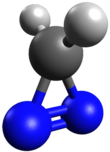| |||
| Identifiers | |||
|---|---|---|---|
| |||
3D model (JSmol)
|
|||
| 605387 | |||
| ChEBI |
| ||
| ChemSpider |
| ||
PubChem CID
|
| ||
CompTox Dashboard (EPA)
|
| ||
| |||
| |||
| Properties | |||
| CH2N2 | |||
| Molar mass | 42.041 g·mol−1 | ||
| Related compounds | |||
Related compounds
|
1H-Diazirine | ||
Except where otherwise noted, data are given for materials in their standard state (at 25 °C [77 °F], 100 kPa).
| |||

In organic chemistry, diazirines are a class of organic molecules consisting of a carbon bound to two nitrogen atoms, which are double-bonded to each other, forming a cyclopropene-like ring, 3H-diazirine (>CN2). They are isomeric with diazocarbon groups (>C=N=N), and like them can serve as precursors for carbenes by loss of a molecule of dinitrogen. For example, irradiation of diazirines with ultraviolet light leads to carbene insertion into various C−H, N−H, and O−H bonds.[1] Hence, diazirines have grown in popularity as small, photo-reactive, crosslinking reagents.[2] They are often used in photoaffinity labeling studies to observe a variety of interactions, including ligand-receptor, ligand-enzyme, protein-protein, and protein-nucleic acid interactions.[3]
- ^ Dubinsky, Luba; Krom, Bastiaan P.; Meijler, Michael M. (2012-01-15). "Diazirine based photoaffinity labeling". Bioorganic & Medicinal Chemistry. Chemical Proteomics. 20 (2): 554–570. doi:10.1016/j.bmc.2011.06.066. PMID 21778062.
- ^ Hill, James R.; Robertson, Avril A. B. (2018). "Fishing for Drug Targets: A Focus on Diazirine Photoaffinity Probe Synthesis". Journal of Medicinal Chemistry. 61 (16): 6945–6963. doi:10.1021/acs.jmedchem.7b01561. PMID 29683660.
- ^ Sinz, Andrea (2007-04-01). "Investigation of protein-ligand interactions by mass spectrometry". ChemMedChem. 2 (4): 425–431. doi:10.1002/cmdc.200600298. ISSN 1860-7187. PMID 17299828. S2CID 23769515.

